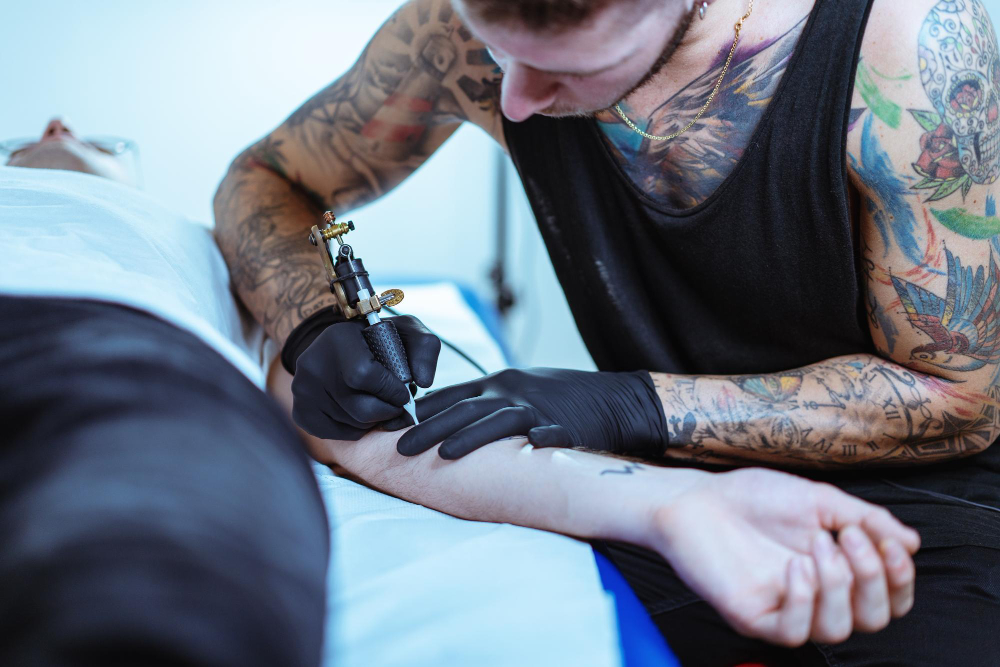Tattoos are more popular than ever, but science is only beginning to catch up with how tattoo ink interacts with the human body. While most people think of tattoos as “skin deep,” research shows pigments don’t always stay put. They can migrate into the lymphatic system, sometimes leading to cancer scares — and in rare cases, raising real concerns.
This doesn’t mean tattoos are “toxic time bombs,” but it does mean the conversation about their safety is more complex than most people realize.
Tattoo Pigment and the Lymphatic System
When tattoo ink is injected into the skin, your immune system recognizes it as foreign. Macrophages (specialized immune cells) rush to the scene. Some remain in the dermis, holding pigment in place so you can see the tattoo. Others engulf ink particles and travel deeper, draining through lymphatic vessels into regional lymph nodes.
This can lead to two main consequences:
- Imaging that mimics cancer
- Lymph nodes filled with pigment can look abnormal on ultrasound (showing enlargement or loss of normal structure).
- On PET/CT scans, they can “light up” with increased uptake, mimicking breast cancer metastasis, melanoma spread, or lymphoma.
- Several case reports describe patients rushed toward oncologic workups, only to find their nodes packed with tattoo pigment rather than malignant cells (PubMed, 2015, Ajops, 2022).
- Immune and inflammatory reactions
- Certain pigments (especially reds and yellows) contain heavy metals like mercury sulfide or azo dyes, which can provoke immune activation.
- This can cause chronic rashes, granulomas, or delayed hypersensitivity reactions, sometimes years after the tattoo was placed.
- In some cases, pigment-filled lymph nodes have been misdiagnosed as sarcoidosis or other autoimmune conditions (PubMed, 2017).
Tattoos and Cancer Risk: What the Research Says
The more unsettling question is whether tattoos increase actual cancer risk. The evidence isn’t definitive, but it is worth watching closely.
- Case reports: There are rare instances of melanoma, basal cell carcinoma, and squamous cell carcinoma developing within tattoos. Whether the tattoo caused them is unclear — since tattoos often cover sun-exposed skin, ultraviolet damage may still be the primary culprit.
- Animal and mechanistic studies: Some tattoo pigments, especially when broken down by UV light or laser treatments, can release aromatic amines and polycyclic aromatic hydrocarbons — compounds known to be carcinogenic in other settings (NCBI, 2021).
- Population studies: A 2023 Swedish cohort of over 11,000 individuals suggested a modestly increased risk of malignant lymphoma among tattooed people, particularly those with larger body surface area coverage (Lancet, 2024). More research is needed before we can say whether tattoos truly cause lymphoma or whether confounding factors are at play.
If You Already Have Tattoos: What’s the Best Approach?
For the millions who already have tattoos, here’s the critical question: what now?
- Don’t panic: The majority of tattooed individuals will never experience tattoo-related health problems. Pigment migration is relatively common, but serious complications are rare.
- Be cautious with removal: Laser tattoo removal may sound like the safest way to “undo” a tattoo, but it can actually create new risks. Lasers fragment pigment into smaller particles that are more likely to circulate and lodge in lymph nodes. Some pigments (especially azo dyes) can break down into potentially carcinogenic compounds under laser exposure. In some studies, laser treatment increased the burden of pigment in lymphatic tissue rather than decreasing it.
- Support detox pathways: From a functional medicine perspective, reducing your overall toxic load matters. This includes optimizing liver function (glutathione, cruciferous vegetables, sulforaphane), hydration, and lymphatic flow (exercise, sauna, dry brushing). These strategies won’t “erase” tattoo pigment but can support the body’s resilience against chemical exposures. This is especially important if you are removing tattoos.
- Stay vigilant: Keep an eye on tattoos and nearby lymph node regions. Watch for persistent swelling, pigment changes, or unusual rashes. If a lump develops — especially if it’s firm or enlarging — get it evaluated. Imaging and sometimes biopsy are needed to rule out malignancy.
Functional Medicine Takeaways
Tattoos may be one piece of a larger inflammatory puzzle. In functional medicine we look at total body burden — how infections, environmental toxins, diet, stress, and, yes, tattoos may all add up to immune dysregulation.
For patients with unexplained fatigue, autoimmune symptoms, or swollen lymph nodes, tattoos are often overlooked in the history. Yet they can be relevant. Supporting detoxification, calming inflammation, and investigating other root causes remain central strategies.
The Bottom Line
Most tattoos will never cause cancer, but tattoo ink is not biologically inert. Pigment can travel into lymph nodes, mimic cancer on scans, confuse doctors, and in rare instances, may play a role in malignancy.
If you already have tattoos, the best strategy is awareness: know that laser removal isn’t risk-free, support your body’s detox and immune balance, and monitor your health over time.
RESEARCH
https://pubmed.ncbi.nlm.nih.gov/24372317



